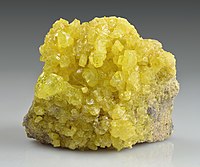
Photo from wikipedia
Complications in the analysis of volatile sulfur compounds (VSC) in wine using solid-phase microextraction (SPME) arise from sample variability. Constituents of the wine matrix, including ethanol, affect the volatility and… Click to show full abstract
Complications in the analysis of volatile sulfur compounds (VSC) in wine using solid-phase microextraction (SPME) arise from sample variability. Constituents of the wine matrix, including ethanol, affect the volatility and adsorption of sulfur volatiles on SPME fiber coatings (Carboxen- polydimethylsiloxane(PDMS); DVB-Carboxen-PDMS and DVB-PDMS), which can impact sensitivity and accuracy. Here, several common wine sulfur volatiles, including hydrogen sulfide (H2S), methanethiol (MeSH), dimethyl sulfide (DMS), dimethyl disulfide (DMDS), dimethyl trisulfide (DMTS), diethyl disulfide (DEDS), methyl thioacetate (MeSOAc), and ethyl thioacetate (EtSOAc) are analyzed, using SPME followed by gas chromatography (GC), using a system equipped with a pulsed-flame photometric detection (PFPD) system, at various ethanol concentrations in a synthetic wine matrix. Ethyl methyl sulfide (EMS), diethyl sulfide (DES), methyl isopropyl sulfide (MIS), ethyl isopropyl sulfide (EIS), and diisopropyl disulfide (DIDS) are evaluated as internal standards. The absorption of volatile compounds on the SPME fiber is greatly affected by ethanol. All compounds exhibit a stark decrease in detectability with the addition of ethanol, especially between 0.0 and 0.5% v/v. However, the ratio of interested sulfur compounds to the internal standard becomes more stable when the total alcohol concentration exceeds 2%. EMS was found to best resemble DMS. EIS and DES were found to best resemble DMDS, MeSOAc, and EtSOAc. DIDS was found to best resemble DEDS, DMTS, H2S, and MeSH.
Journal Title: Molecules
Year Published: 2019
Link to full text (if available)
Share on Social Media: Sign Up to like & get
recommendations!